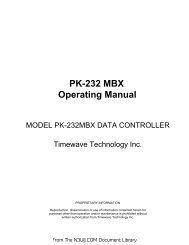DXE-RTR-1 Receive Antenna Interface for Transceivers - N3UJJ
DXE-RTR-1 Receive Antenna Interface for Transceivers - N3UJJ
DXE-RTR-1 Receive Antenna Interface for Transceivers - N3UJJ
- No tags were found...
Create successful ePaper yourself
Turn your PDF publications into a flip-book with our unique Google optimized e-Paper software.
Connect a regulated station power supply which provides a 1 A fused 12 Vdc to the <strong>DXE</strong>-<strong>RTR</strong>-1power connector on the back panel. With the included 2.1 mm power cord, the power connectormust be wired center positive. If a station power supply is not available, connect the optional <strong>DXE</strong>-PSW-12D1A Wall Trans<strong>for</strong>mer.Typical interconnections between the <strong>DXE</strong>-<strong>RTR</strong>-1, the transceiver, antennas and accessoryequipment are made with commonly available or easily made patch cords. Plans should be made tolocate the <strong>DXE</strong>-<strong>RTR</strong>-1 close to the transceiver, so instant reception antenna changes may be madewith the front panel switch.<strong>Receive</strong> only connections must be made with either male RCA phono style patch cords or with maleF connector cables. Custom length cables with F-Connectors installed can be supplied by <strong>DXE</strong>ngineering. If RCA phono style patch cords are used, high quality connectors should be selected<strong>for</strong> this low-noise RF application. Inexpensive audio cables may not be suitable. RCA Phono and F-Connectors are used on DX Engineering receive devices to help prevent accidental connection totransmitting connectors.Transmitting RF connections on the <strong>DXE</strong>-<strong>RTR</strong>-1, from RADIO to the transceiver and from MAINANTENNA to the transmitting antenna system, tuner or amplifier are made with standard PL-259patch cables in lengths that permit locating the equipment in their proper operating positions.Custom length cables with PL-259 connectors installed can be supplied by DX Engineering.The TRANSMIT GROUND keying line connection to the <strong>DXE</strong>-<strong>RTR</strong>-1 must be made to enablereception with a connected receive antenna or accessory. Keying line connection from transceiveror sequencer (grounding keying line only) <strong>for</strong> automatic relay switching of RADIO from the RXANT IN to the to MAIN ANT.This connection may be shared with an amplifier-transceiver interface buffer keying input. Thediagrams in this manual show connections to transceivers with grounded-on-transmit keying lineonly.Note: If the keying line is shared (using a "Y" adapter) with an amplifier or amplifier interfacebuffer, then precautions should be taken to be certain that the transceiver to <strong>DXE</strong>-<strong>RTR</strong>-1connection is not interrupted.If the keying line connection from the transceiver to the TRANSMIT GROUND connector on the<strong>DXE</strong>-<strong>RTR</strong>-1 is lost, transmitted RF may cause damage to the <strong>DXE</strong>-<strong>RTR</strong>-1 or receiving equipment.The TRANSMIT GROUND keying line connector MUST be connected to a groundedon-transmittransceiver keying line, cable shield to radio chassis ground, and the RADIOconnector must be connected to the transceiver RF connector, cable shield to radio chassisground, to enable receive mode.Positive voltage keying will not key the <strong>DXE</strong>-<strong>RTR</strong>-1 properly.Damage to the <strong>DXE</strong>-<strong>RTR</strong>-1 could occur by attempting to use positive voltage keying.Review your transceiver operation manual carefully. <strong>Transceivers</strong> with positive keyingonly, must be connected to an interface buffer to provide grounding-on-transmit keying.10From The <strong>N3UJJ</strong>.COM Document Library
















